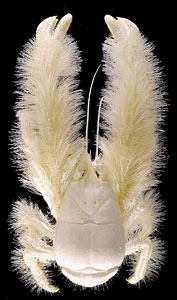While Sri Lanka’s elephant census estimated the number of elephants live in the island to 5,879, an international study revealed a new estimation that there are a total of 8.7 million different species live on Earth.
This has been tagged as the most precise calculation ever offered - with 6.5 million species found on land and 2.2 million (about 25 percent of the total) dwelling in the ocean depths, as per the scientists’ of Census of Marine Life. This also means a staggering 86% of all species on land and 91% of those in the seas have yet to be discovered, described and catalogued.
 |
| The Yeti crab: A newly
found species |
Until now, estimates of the world’s species ranged from three million to 100 million. The new study refined the number by compiling taxonomic data for roughly 1.2 million known species and identifying numerical patterns. The animals are one of the best studied groups and these academics had spotted a predictable ratio of species to broader categories among these known groups. They applied these numerical patterns to all five major kingdoms of life- Animalia, Fungi, Plants, Protozoa (single celled organisms such as Amoebas), Chromista (such as photosynthetic Algae) to derive this more narrow estimate.
The researchers also noted that the recently-updated Red List issued by the
International Union for the Conservation of Nature (IUCN) assessed 59,508 species, of which 19,625 are classified as threatened. This means the IUCN Red List, the most sophisticated ongoing study of its kind, monitors less than 1% of the world’s species.
However, scientists fear that many of these unidentified species will go extinct even before they have been discovered. Earth has so far undergone 5 mass Extinction Crisis and it is believed that we are in the middle of the Sixth Mass Extinction mainly due to ill-effects triggered by human activities.
The ocean depths are also a last hideout for many of the species. The pressure at these depths deny man the ability to explore the area until recently. However new species are increasingly emerging through new studies done using sophisticated remotely operated underwater exploration vehicles that are similar to those used by astronomers.
Based on current costs and requirements, the study suggests that describing all the remaining species using traditional approaches could require up to 1,200 years of work by more than 300,000 taxonomists at an approximate cost of $US 364 billion. Fortunately, new techniques such as DNA barcoding are radically reducing the cost and time involved in new species’ identification.
Considering the land species, the tropical countries like Sri Lanka have the potential to discover the majority of the new species. The tropical rainforests like Sinharaja are refuge to high biodiversity and continued discoveries of new species testify the need for more research to identify the rest of the species living in these areas. It is important that Sri Lankan researchers too are given access to new techniques and equipment in discovering the new species which will also heighten the need of conserving the remaining habitats in order to protect the species. |


